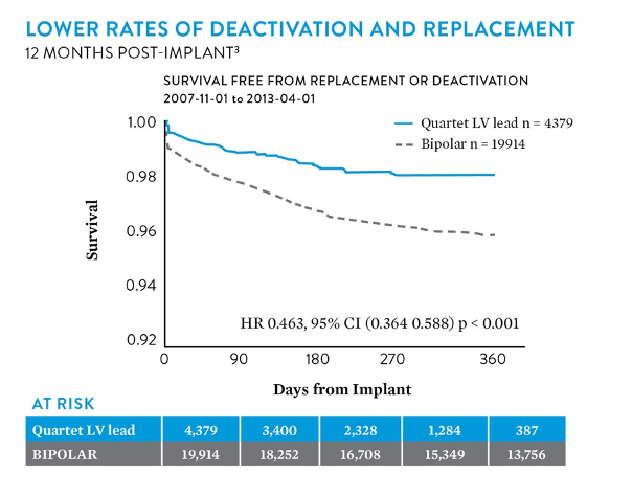Clinical Evidence
Quadripolar Advantages for Cardiac Resynchronization Therapy
Cardiac resynchronization therapy (CRT) is an effective treatment for heart failure, and it can help your patients avoid life-threatening changes in heart rhythm. CRT can also alleviate many of the symptoms experienced by your patients, improving their overall quality of life.
Quadripolar technology offers a significant advantage over bipolar technology—giving you the flexibility you need to access pacing sites and vectors outside of the reach of most devices, without compromising lead stability or performance.
Quartet™ LV Lead Provides Excellent Outcomes
When used in conjunction with our innovative suite of quadripolar technology-enabled CRT solutions, the Quartet LV lead supports improved patient outcomes.
- After 18 months, 97.4% of patients were successfully implanted with the quadripolar system. Once placed, the LV lead remained stable with excellent pacing thresholds during follow-up (15 ± 5 months)1
- The Quartet LV lead was used to address phrenic nerve stimulation (PNS) noninvasively in 100% of cases2
- Use of quadripolar pacing technology resulted in:
- Lower risk of lead deactivation or replacement than bipolar leads4
- Significantly lower capture thresholds in comparison to unipolar or bipolar leads3
- Very low dislodgment rates3
- Among patients with high capture thresholds, the use of a quadripolar lead has extended battery life by up to 17 months4
Reduces Patient and Hospital Costs
Cost analysis performed on a single-center registry showed the Quartet quadripolar LV lead was associated with significantly reduced hospitalizations, specific to heart failure (HF) and left ventricular (LV) lead surgical revision.5
Study Results
- In-patient heart failure hospitalization rates and LV lead surgical revisions were 54% lower for the quadripolar group (0.15/patient-year than for the bipolar LV group (0.32/patient-year) (p = 0.04).5
- The hospitalization rate reduction was accompanied with statistically significant cost savings of 62% (p = 0.016).5
Benefits of Quadripolar Technology
The use of quadripolar technology offers you and your hospital or clinic many clinical, economic and operational advantages over bipolar technology, including:
Reduced cost
39.8% reduction in
Heart Failure hospitalization cost6
54% lower
hospitalization rate5
Overall cost savings
(effective resource utilization)7
32.1% reduction
of 30-day readmission rate6
Reduction in phrenic nerve
stimulation (PNS)8
and surgical lead revisions9
Improved outcomes
22% relative reduction
in all-cause mortality10
Increase in dP/dt with biventricular
(BiV) pacing
at site of late activation11
Improved hemodynamics12
Operational efficiency, implant success and lead performance
In clinical studies, quadripolar pacing technology has resulted in:
- Significantly lower risk of lead deactivation or replacement than bipolar leads3

Our Quadripolar CRT System is Associated with Increased Survival
Patients with a quadripolar system may receive more effective CRT than those with bipolar LV pacing:4
Mortality Results
Mortality incidence was significantly lower in the quadripolar group.10
- Quadripolar: 5.04 deaths per 100 patient-years
- Bipolar: 6.45 deaths per 100 patient-years (p = 0.001)
After multivariate adjustment, the quadripolar lead was associated with a lower risk of death HR: 0.77; 95% CI: 0.69 to 0.86; p < 0.001.10
Mortality Conclusions
CRT with quadripolar LV system was associated with a 22% relative reduction in mortality compared with a bipolar LV system.10
References
- Forleo, G. B., Mantica, M., Di Biase, L., Panattoni, G., Della Rocca, D. G., Papavasileiou, L. P., … Romeo, F. (2012). Clinical and procedural outcome of patients implanted with a quadripolar left ventricular lead: Early results of a prospective multicenter study. Heart Rhythm, 9(11), 1822-1828. https://dx.doi.org/10.1016/j.hrthm.2012.07.021
- Tomassoni, G. Baker, J., Corbisiero, R., Love, C., Martin, D., Niazi, I., … Zhang, Z. (2013). Post-operative performance of the Quartet™ Left Ventriocular Heart Lead. J Cardiovasc Electrophysiol 24(4). 449-456. https://dx.doi.org/10.1111/jce.12065
- Turakhia, M. P., Gold, M. R., Fischer, A., Sloman, L. S., Kumar, C., Dalal, N., … Cao, M., (2013). Decreased rate of left ventricular lead deactivation and replacement associated with use of quadripolar LV leads. Europace, 15(Suppl. 2), S47. https://dx.doi.org/10.1093/europace/eut169
- Manyam, H., Bhimani, A. A., Sadrpour, S. A., De Oliveira, S. A., Goldstein, R., N., Cakulev, I., … Mackall, J. (2013). Quadripolar left ventricular leads yield lower capture thresholds with expected increase in battery longevity. Heart Rhythm, 10(5) S228. https://doi.org/10.1016/j.hrthm.2013.03.019
- Forleo, G. B., Di Biase, L., Bharmi, R., Dalal, N., Panattoni, G., Pollastrelli, A., … Romeo, G. (2015). Hospitalization rates and associated cost analysis of cardiac resynchronization therapy with an implantable defibrillator and quadripolar vs. bipolar left ventricular leads: a comparative effectiveness study. Europace, 17(1), 101-107. https://dx.doi.org/10.1093/europace/euu290
- Corbisiero, R., Kazemian, P., Bharmi, R., Shar, R., Muller, D. (2016). Less with More: Hospitalization cost and Event Rates with Quadripolar versus Bipolar CRT-D. PACE 39(10). 1038-1045. https://dx.doi.org/10.1111/pace.12923
- Graham, C. M., Gayle, J., & Magee, G. (2014, May). Comparison of healthcare utilization and hospital costs for quadripolar versus bipolar LV lead technologies. Presented at the meeting of the Heart Rhythm Society, San Francisco, CA.
- Mehta, P. A., Shetty, A. K., Squirrel, M., Bostock, J., & Rinaldi, C. A. (2012). Elimination of phrenic nerve stimulation occurring during CRT: Follow-up in patients implanted with a novel quadripolar pacing lead. Journal of Interventional Cardiac Electrophysiology, 33(1), 43-49. https://dx.doi.org/10.1007/s10840-011-9598-5
- Viani, S. M., Segreti, L., Di Cori, A., Zucchelli, G., Paperinin, L., Soldati, E., … Bongiorni, M. G. (2011). A new quadripolar lead for left ventricular pacing: Short term reliability and future opportunities. Europace, 13(Suppl. 3).
- Turakhia, M., Cao, M., Fischer, A., Nabutovsky, Y., Sloman, L. S., Dalal, Nirav., Gold, M. R. (2018). Reduced mortality associated with quadripolar compared to bipolar left ventricular leads in cardiac resynchronization therapy. J Am Coll Cardiol EP. 2(4). 426-33. https://dx.doi.org/10.1016/j.jacep.2016.02.007
- Pappone, C., et al. (2012, October). Left ventricular pacing from a site of late electrical activation improves acute hemodynamic response to cardiac resynchronization therapy. Presented at the meeting of the Asia Pacific Heart Rhythm Society, Taipei, Taiwan.
- Gutleben, K. J., Kranig, W., Barr, C., Morgenstern, M. M., Simon, M., & Dalal, Y. H. (2011). LV-pacing: Vector optimization using a novel quadripolar electrode acutely improves cardiac output in cardiac resynchronization therapy patients. Europace, 13(3), P403.
MAT-2012188 v2.0
